Product
Introducing a New End-to-End SEO Workflow That Scales High-Quality, User-Centric Content Production 6x Faster

Saachi Shah · Product Manager
January 29th, 2025 · 7 min read
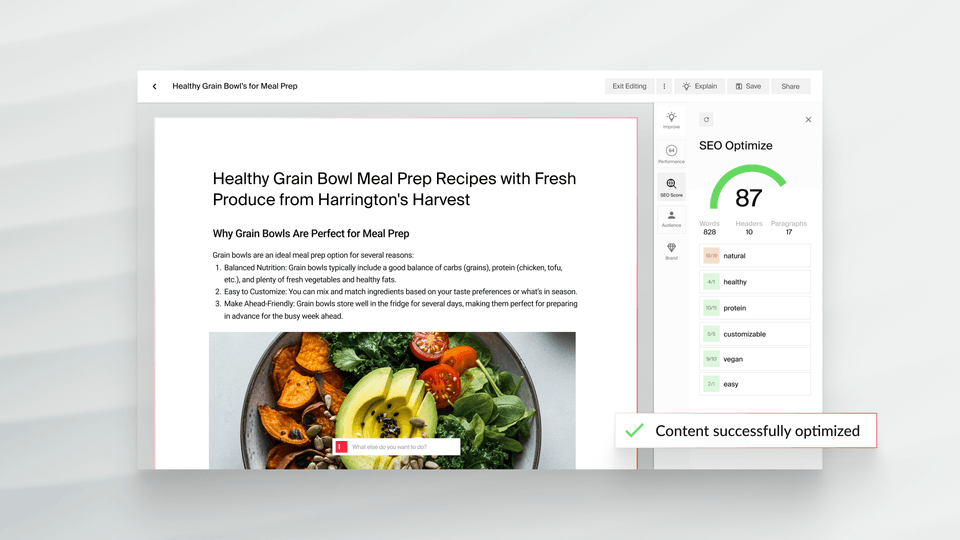
When a leading healthcare insurer's content team came to us, their SEO writers were spending six weeks on each piece of content. Their days were consumed by manual research: analyzing Semrush data, studying competitor content structures, and searching forums for "People Also Ask" questions – while their content backlog kept growing. By adopting AI trained on their specific audience, data, and brand voice, they now produce the same high-quality, traffic-driving content in just one week before legal reviews – an 83% reduction in production time that's cleared their backlog and strengthened their search rankings.
This transformation couldn't have come at a better time. Recent changes in Google's algorithm now prioritize "depth over breadth" in content, rewarding websites that provide comprehensive, authoritative information while penalizing shallow, generic content. For enterprises managing thousands of pages across multiple domains, this raises a crucial question: How do you scale content production while maintaining the depth and quality needed to succeed in today's SEO landscape?
That's why we're excited to announce our expanded suite of SEO capabilities – introducing a complete end-to-end workflow that transforms weeks of manual research, content creation, and optimization into a streamlined process that takes minutes. Our new solution brings together competitive research, content creation, and performance tracking combined with our deep understanding of each brand’s audiences, brand, and data, helping enterprises scale their SEO content without sacrificing quality.

What marketers truly need to succeed in SEO today
In our conversations with marketing teams, one thing becomes clear: they're not looking to simply clone what's already ranking. They want to create distinctive content that genuinely serves their audience while climbing search rankings. Here's what's standing in their way:
Scattered research kills productivity: SEO teams toggle between multiple tools – analyzing competitor pages and pulling keywords and traffic metrics from tools like Semrush. This fragmented approach doesn't just waste time; it prevents teams from spotting the patterns that drive ranking success.
The hidden value in "People Also Ask": "PAA reveals the pain points for your topic – it's what turns at-par content into above-par content," shared one SEO expert we work with. But, gathering these insights means manually searching across Google, Quora, and Reddit. Marketers need a faster way to get a quick list of PAA questions.
Scale vs. depth in keyword strategy: Manually analyzing hundreds of keywords across dozens of top-ranking pages isn't just inefficient, it's impossible at enterprise scale. You need deep SEO expertise to identify which keywords actually move the needle.
Quality keyword optimization: Just knowing which keywords to target and simply stuffing target keywords into existing content doesn't work. Writers need to weave keywords naturally while maintaining their authentic voice.
Performance visibility gap: Publishing with confidence requires competitive benchmarking. While some teams use advanced text analysis tools, these often lack competitor context. Marketers need a scoring system that shows how their content compares to top performers.
Our approach to the new SEO playbook for quality content at scale
Today, we launched our new end-to-end SEO workflow that guides marketers through every step of content creation and optimization. Here's how we're solving each challenge:
Integrated workflows: End the constant switching between tools. Access Semrush analytics, Google Insights, and on-brand content creation capabilities in one place with direct publishing via our built-in connectors.
Competitive analysis: Replace manual competitor research with AI-powered insights. Our system analyzes top-performing content to identify effective content structures, recommended lengths, and valuable PAA questions you should address.
Smart keyword suggestions: Gone are the days of manually scraping countless pages for keywords. Typeface’s proprietary technology analyzes high-traffic content in your space to suggest the most relevant primary and secondary keywords, helping you focus on terms that matter for your audience.
Create and refresh content: Whether creating new content or updating existing pieces, our SEO Blog Post template and "Refine with SEO" feature help you incorporate keywords naturally while personalizing to your brand and audiences for in-depth, user-centric content.
SEO scoring and insights: Compare your content against top competitors with comprehensive scoring. No more guessing if your content will perform – track keyword frequency in your content to know exactly where to strengthen your optimization.
How it works
Step 1: Start with new or existing content
To create new content, use the SEO Blog Post template to generate blog outlines and drafts on your chosen topic. To refresh existing content, click on “+ Insert asset” in your document copilot, share your content, and select “Refine with SEO.”
💡 Pro tip: When entering a blog topic, enter around one to two sentences maximum.

Step 2: Personalize to brand and audiences
Under the SEO Blog Post’s settings, specify your Brand Kit and Audiences. Click “Apply Settings” and “Next” to then attach relevant documents related to your topic.
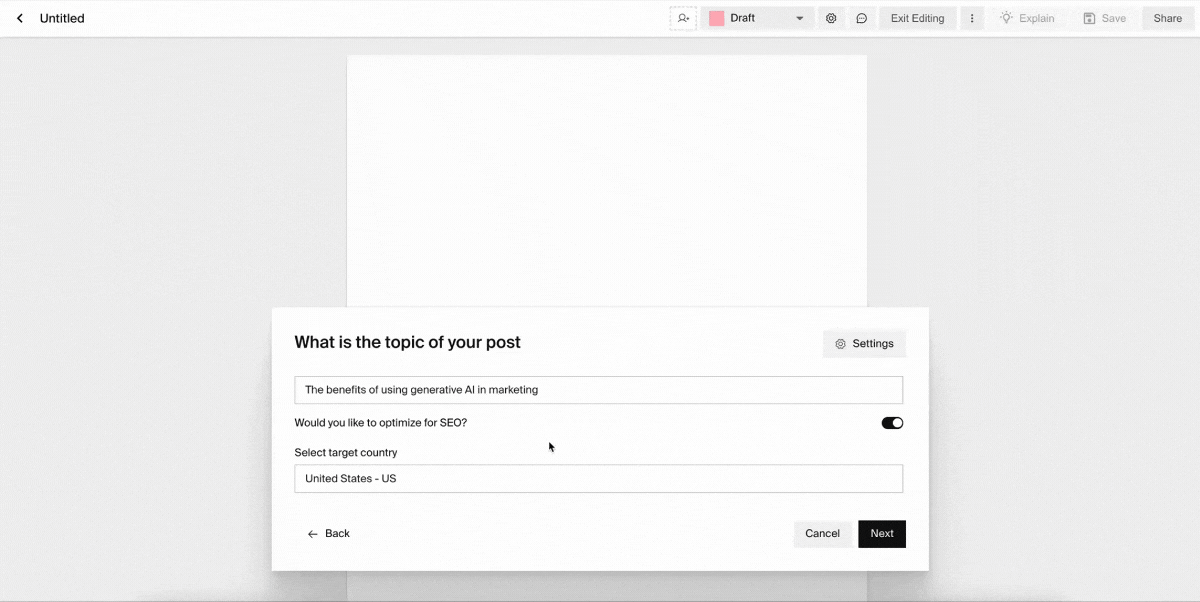
Step 3: Choose keywords to optimize
Based on your blog topic or uploaded content, Typeface will automatically recommend keywords. Primary keywords are featured in headers and titles, while secondary keywords are incorporated throughout the body content. Select keywords that balance search volume with audience relevance—or add your own custom keywords.
💡 Pro tip: We recommend selecting 1-2 primary keywords and 4-5 secondary keywords.
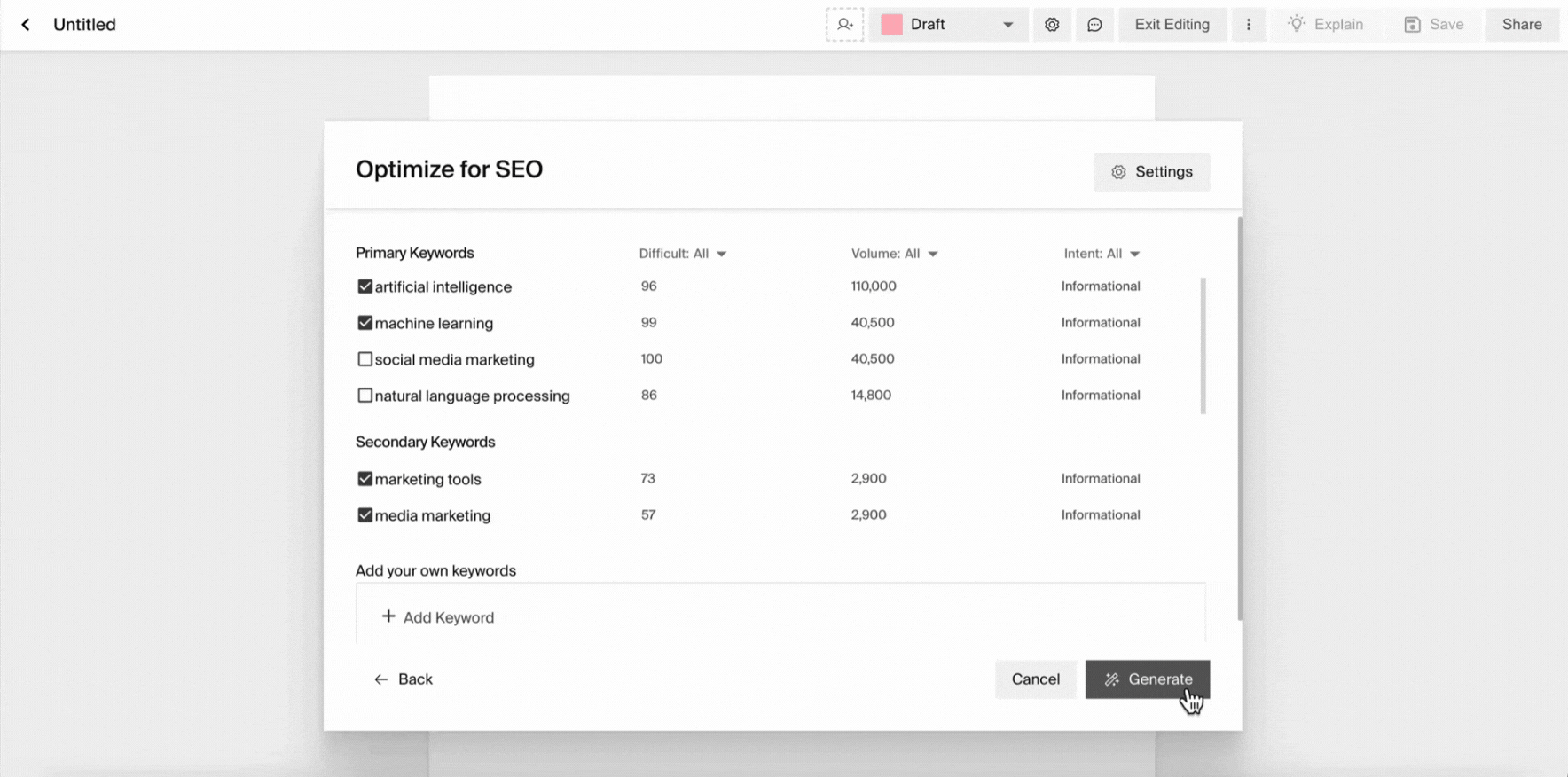
Step 4: Refine your outline using competitive insights
Under the “Explain” panel, you can see what works for top-performing content in your space. This helps you adapt successful content structures and optimal content lengths from high-ranking pages. Then incorporate relevant FAQs sourced across Google, Quora, and Reddit to take your content to the next level.
💡 Pro tip: Incorporate the FAQ or competitor structure into your blog outline before generating the blog post.
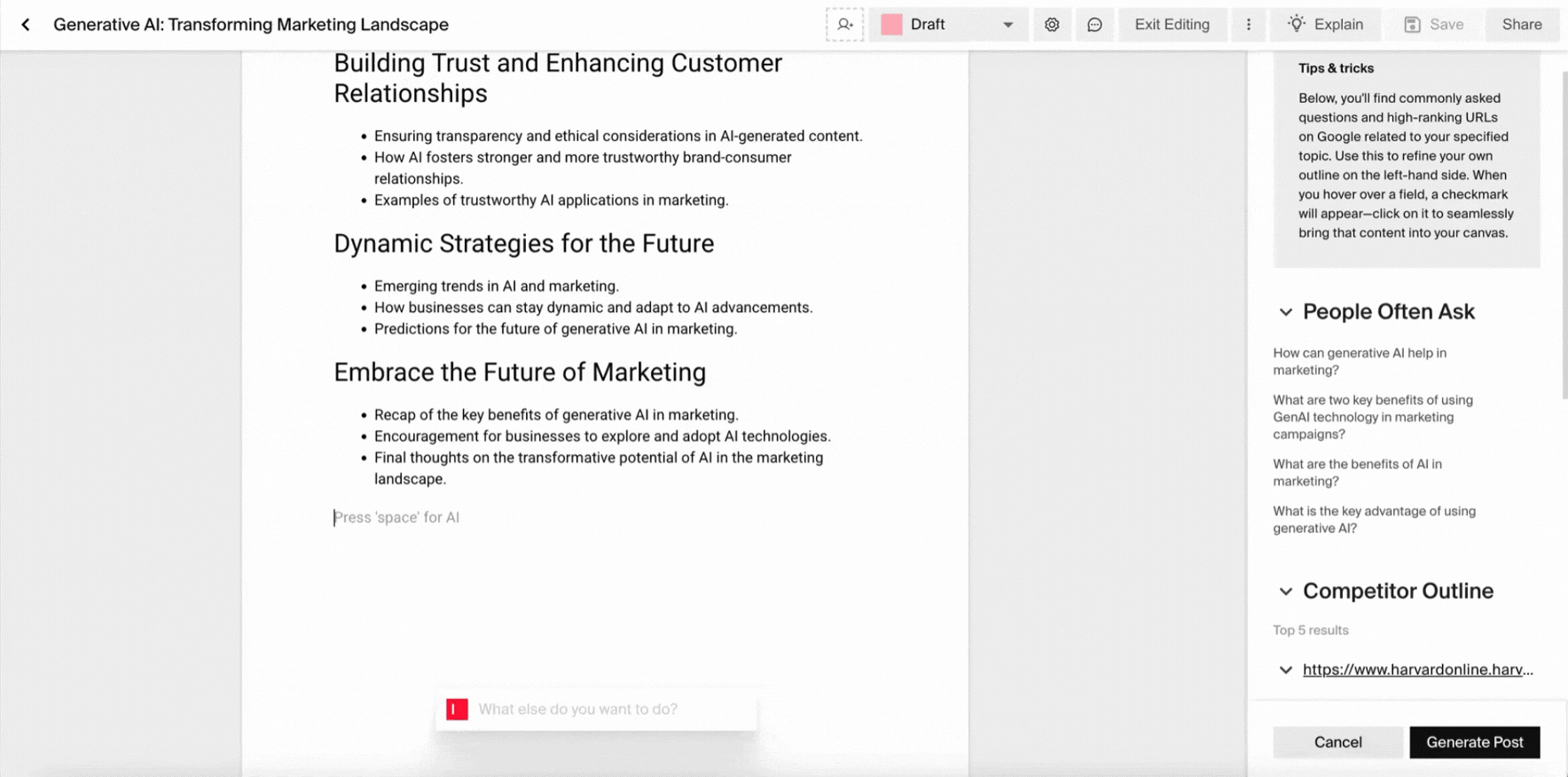
Step 5: Track and improve performance
The “Explain” panel’s SEO tab shows the overall SEO score and the frequency of each keyword, which helps you find opportunities for better keyword integration.
The SEO score is calculated using four key metrics:
Words score: Compares your content's word count against top-performing competitor blog posts
Headers score: Evaluates how many headers you’ve organized compared to competitor blog posts
Paragraph score: Assesses your content's paragraph number and structure in relation to competitor blog posts
Keywords score: Measures the presence of your selected keywords within the generated content
💡 Pro tip: Regularly refresh your content to ensure it remains competitive in search rankings.
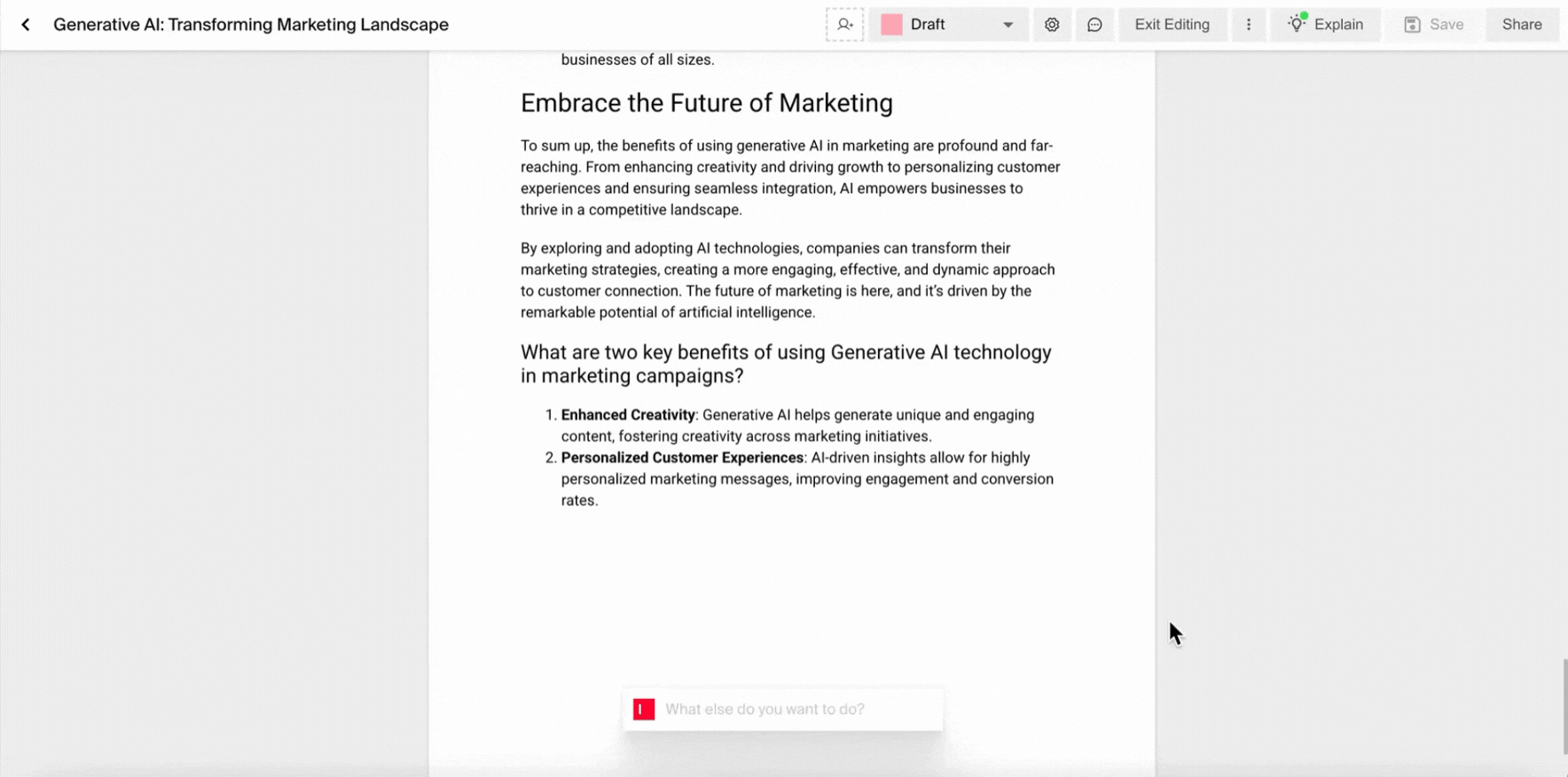
Get started today
As search engines evolve and content demands grow, traditional manual workflows are no longer sustainable. Typeface automates research and brings creation and optimization directly into the content workflow. Teams can finally focus on crafting unique insights, developing distinctive brand voices, and building content that truly resonates with their audience with the help of an AI SEO content generator.
Sign up for a 30-day free trial or watch our webinar: Transform Manual SEO with AI Workflows.
Share
Related articles
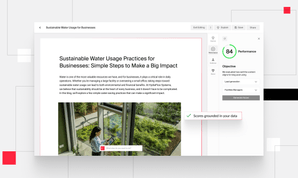
Product
Demystifying AI: Bringing Trust and Actionable Insights into Your Content Workflow

Saachi Shah · Product Manager
October 16th, 2024 · 5 min read

AI at Work
AI for SEO - 7 Powerful Tips to Integrate AI Into SEO Content Writing

Neelam Goswami · Content Marketing Associate
November 28th, 2024 · 12 min read
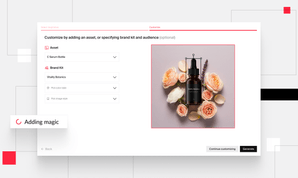
Product
Beyond Prompts: A New Way to Ideate and Create Using Images in Visual Inspiration Studio

Frank Chen · Product Manager
October 9th, 2024 · 6 min read